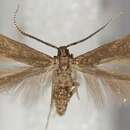en
names in breadcrumbs


Coleophora fuscocuprella is a moth of the family Coleophoridae. It is found from Fennoscandia to the Pyrenees, Italy, Albania and Romania and from Ireland to Russia.
The wingspan is 8–10 mm (0.31–0.39 in).[2] The head is shining dark bronzy-fuscous, and the antennae are dark fuscous; apical half white with dark fuscous rings, indistinct towards apex. The forewings are dark bronzy-fuscous, and the hindwings are dark grey.[3]
There is one generation per year with adults on wing from mid-May to late June.[4]
The larvae feed on alder (Alnus species), silver birch (Betula pendula), downy birch (Betula pubescens), European hornbeam (Carpinus betulus) and hazel (Corylus avellana). They create a lobe case with many small leaf fragments attached to it. The larvae are attached to the leaf underside, where they make a large number of relatively small fleck mines.[5] Full-grown cases can be found in August and October. Pupation takes place in the case, usually attached to a trunk just above ground level.
Coleophora fuscocuprella is a moth of the family Coleophoridae. It is found from Fennoscandia to the Pyrenees, Italy, Albania and Romania and from Ireland to Russia.
The wingspan is 8–10 mm (0.31–0.39 in). The head is shining dark bronzy-fuscous, and the antennae are dark fuscous; apical half white with dark fuscous rings, indistinct towards apex. The forewings are dark bronzy-fuscous, and the hindwings are dark grey.
There is one generation per year with adults on wing from mid-May to late June.
The larvae feed on alder (Alnus species), silver birch (Betula pendula), downy birch (Betula pubescens), European hornbeam (Carpinus betulus) and hazel (Corylus avellana). They create a lobe case with many small leaf fragments attached to it. The larvae are attached to the leaf underside, where they make a large number of relatively small fleck mines. Full-grown cases can be found in August and October. Pupation takes place in the case, usually attached to a trunk just above ground level.